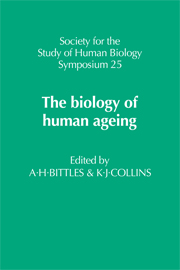Book contents
- Frontmatter
- Contents
- Preface
- Ageing as a consequence of natural selection
- Genetic information in ageing cells
- Insects as models for testing theories of ageing
- Human cell culture systems in the study of ageing
- Estimation of biological maturity in the older child
- Biological age assessment in adulthood
- Skeletal age and palaeodemography
- Cell death and the loss of structural units of organs
- The prospects for mortality decline and consequent changes in age structure of the population
- Where do old people come from? An evaluation of American population projections
- Age structure of Soviet population in the Caucasus: facts and myths
- The health of an ageing population
- Can we tell our age from our biochemistry?
- Dietary manipulation of ageing: an animal model
- Customary physical activity in the elderly
- Effects of ageing on human homeostasis
- Index
Insects as models for testing theories of ageing
Published online by Cambridge University Press: 06 August 2010
- Frontmatter
- Contents
- Preface
- Ageing as a consequence of natural selection
- Genetic information in ageing cells
- Insects as models for testing theories of ageing
- Human cell culture systems in the study of ageing
- Estimation of biological maturity in the older child
- Biological age assessment in adulthood
- Skeletal age and palaeodemography
- Cell death and the loss of structural units of organs
- The prospects for mortality decline and consequent changes in age structure of the population
- Where do old people come from? An evaluation of American population projections
- Age structure of Soviet population in the Caucasus: facts and myths
- The health of an ageing population
- Can we tell our age from our biochemistry?
- Dietary manipulation of ageing: an animal model
- Customary physical activity in the elderly
- Effects of ageing on human homeostasis
- Index
Summary
INTRODUCTION
It seems that until the 1920s the only species for which there was a complete life table was our own (Pearl, 1928). However, in 1921, in the first of a long series of papers with the general title “Experimental Studies on the Duration of Life”, Pearl and Parker remedied this situation by providing a complete life table for a second species. This species was an insect, the fruit fly Drosophila melanogaster. Raymond Pearl seems to have had few reservations about using an insect as a model for the study of human ageing and longevity; frequently he presented the survival curves for Drosophila and man on a single graph to show how similar they are. Subsequently many other workers have studied insect ageing and longevity, and have pointed out the relevance of their studies to ageing in man. Of course, it would be foolish to argue that insects can be an entirely adequate model for the study of human ageing, or even that they can be used for testing all theories of ageing. Quite clearly, they are of little value for testing theories of ageing which, for example, give a primary role to the immune system, or to the neuroendocrine system. However, many theories of ageing should be applicable to all species that show age-dependent deteriorative changes, since they suggest that senescence is the result of timedependent changes in the cells and molecules which make up all multicellular organisms. For testing these theories, insects should be at least as suitable as any other organism.
- Type
- Chapter
- Information
- The Biology of Human Ageing , pp. 33 - 48Publisher: Cambridge University PressPrint publication year: 1986



